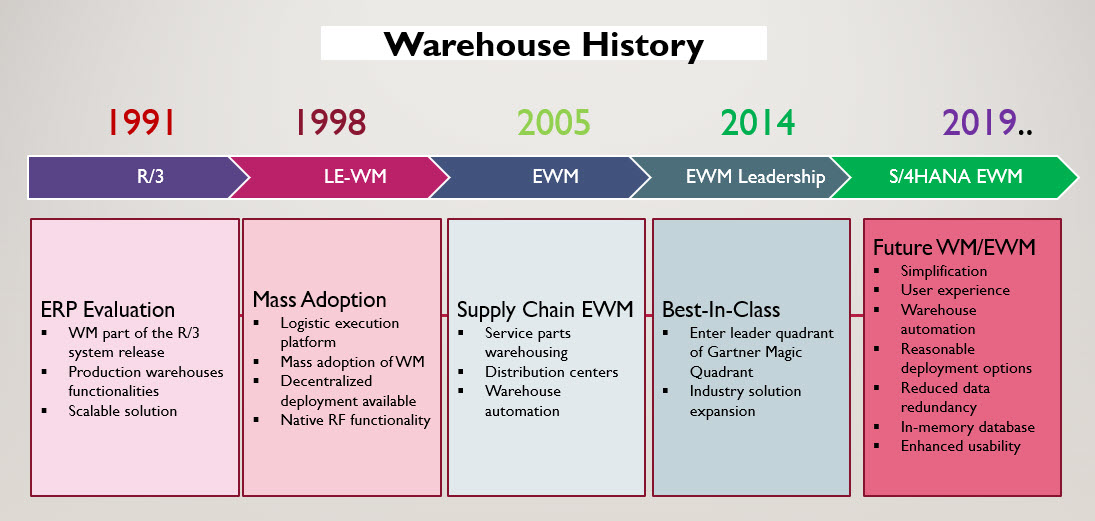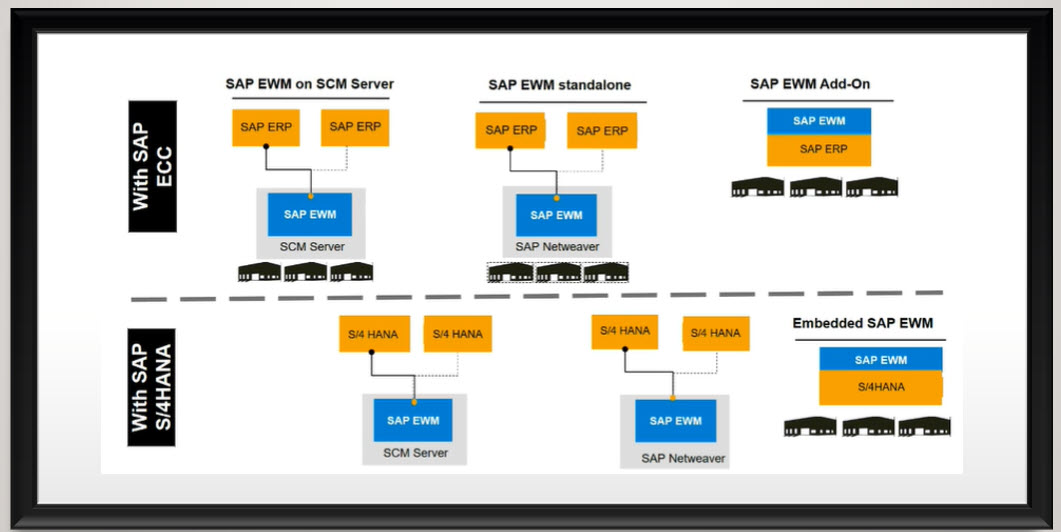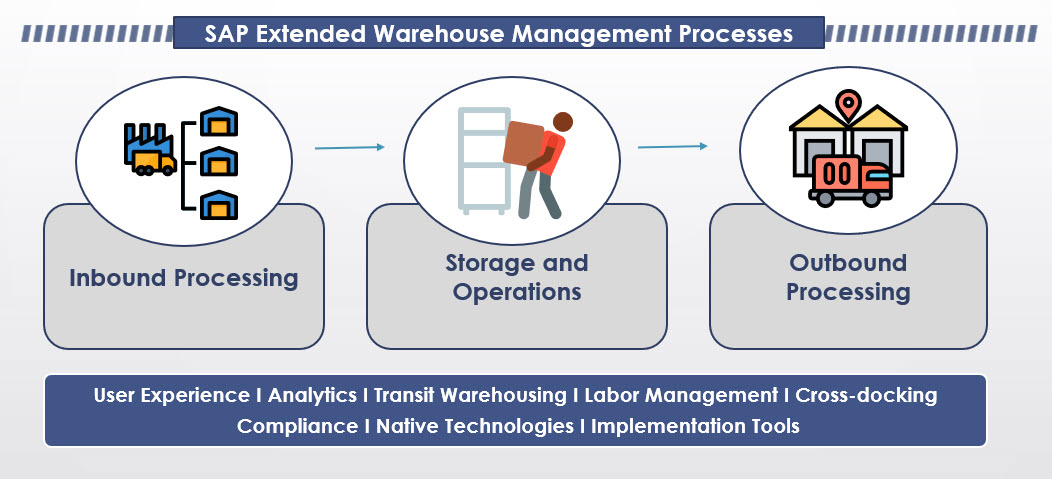SAP Extended Warehouse Management (EWM) is used to efficiently manage inventory in the Warehouse and for supporting the processing of goods movement. It allows the company to control its Warehouse inbound and outbound processes and movement of goods in the Warehouse.
The main process in a Warehouse is incoming and outgoing materials, goods receipt and goods issue, fulfill customer orders, and distribution of goods. When a company doesn’t store any goods, then there is no need for Warehouse management to manage goods.
With the help of SAP EWM, all the goods movements are controlled by a warehouse management system and provides you the tools to monitor warehouse activities. You can also manage additional functions in the Warehouse like creating a serial number, batch number, vendor management inventory, resource optimization, and value-added services. SAP Extended Warehouse Management allows you to not only monitor the quantity of goods in Warehouse but to manage other critical functions and delivery of goods efficiently.

SAP Extended Warehouse Management
SAP S/4 HANA, the Digital Core, is the next generation of ERP to modernize for Digital Business. The SAP lines of business solutions continue to be consumed as standalone solutions or as part of the SAP S/4HANA Lines of Business solutions giving more choice to customers, allowing true hybrid scenarios and incremental deployments.
In Q4/2016, SAP EWM became an embedded application component within SAP S/4HANA (on-premise edition 1610), known as S/4HANA
Supply Chain Management for extended warehouse management. To make it simple, we’ll call it “embedded EWM”. With the release of it, both basic warehousing and extended warehouse management are running on a common code base embedded in SAP S/4HANA.
SAP Extended Warehouse Management (SAP EWM) is now available as an embedded application in SAP S/4HANA. It combines best-in-class proven warehouse management capabilities with the benefits of SAP S/4HANA.
Technically, the simplified integration of the embedded EWM within the on-premise edition of S/4HANA is reached by the adoption of a unified data model (that is, new product code line). The goal is to simplify the data model as much as possible. The major simplifications are as follows:
-
- Core Interface is not used any more for master data including a business
partner, material master and batch.
- Core Interface is not used any more for master data including a business
-
- Redundant customizing tables are eliminated.
-
- Direct read of actual data in SAP S/4HANA is realized instead of
replication, for example, material values, accounting objects, purchase
orders, production orders, etc..
- Direct read of actual data in SAP S/4HANA is realized instead of

Deployment Options
SAP Note 1606493 ‘SAP EWM Deployment Options Best Practices’ provides some hints on the various different decision criteria. The embedded EWM in S/4HANA is similar to EWM-on-ERP. One of the important decision criteria is the system sizing. SAP offers a Quicksizer tool which also provides a ‘HANA version’ of Quick Sizing. Within the HANA Version of the Quick Sizer Tool you
find the embedded EWM sizing tool in ‘SAP S/4HANA->EWM Inbound’ and ‘SAP S/4HANA->EWM Outbound’.
In case of large rollout plans SAP recommends an SAP DBS service to evaluate the specific requirements and boundary conditions and to create a recommended proposal for EWM deployment strategy. SAP already has experience in such a service including the new option of the embedded EWM in S/4HANA.
EWM and WM can be run in parallel on a single S/4HANA client. The warehouses must be linked to different storage locations. It is not possible to run a single warehouse (single storage location) with a mixture of WM and EWM processes.

Key Capabilities

Inbound processing
-
- Transportation unit processing; goods receipt management and optimization
-
- Inbound quality management and internal routing
Storage and operations
-
- Physical inventory, slotting, replenishment, and rearrangement
-
- Kit-to-stock management and value-added services
Outbound processing
-
- Outbound planning including route, wave management, goods issue, and pallet planning
-
- Picking optimization, packing, staging, and load management
Warehouse Management Portfolio
Embedded EWM in S/4HANA is available in two versions:
-
- Basic Warehouse Management
-
- Extended Warehouse Management
Refer to the Feature Scope Description of SAP S/4HANA 1909 for an overview of the features contained in each version.
Both versions are available with the SAP S/4HANA installation. You set up the warehouse management version at the warehouse number level. You can change the version used by a warehouse at any point in time.
Basic warehousing functions of embedded SAP EWM are included in the SAP S/4HANA Enterprise Management license. Advanced functions will require the classic SAP EWM engine license. The Advanced and Basic functions are as follows:

The de-central EWM always requires the classic SAP EWM engine license no matter using advanced or basic features or not.
Major Differences WM and S/4HANA EWM

Major differences between EWM in SAP S/4HANA 1909 and decentral SAP EWM 9.5
EWM in SAP S/4HANA and SAP EWM 9.5 share a common core of warehouse management functions. They support the same business scenarios and processes with only minor exceptions:
-
- Embedded EWM in SAP S/4HANA offers a simplified integration into other SAP S/4HANA applications
-
- EWM in SAP S/4HANA provides additional functionality
-
- Some restrictions apply in embedded EWM in SAP S/4HANA
Restrictions of embedded EWM in S/4HANA 1909 compared to functions that are generally available in SAP S/4HANA:
-
- Batch derivation
-
- Batch-specific unit of measure and active ingredients – see also SAP note 2432414
-
- Interchangeable Manufacturer Parts
-
- International address versions for locations and supply chain units
-
- Special stock indicators other than E (Orders on hand), K (Vendor Consignment), M (Returnable Packaging from Vendor), Q (Project Stock)
-
- Valuated stock in transit (SiT) processes with EWM-managed storage locations (but STO processes without valuated SiT are supported) – see also SAP note 1822497
-
- VMS and JIT processes as described in SAP note 2825796
-
- Restrictions related to QM integration:
-
- Inspection lot in the material inspection in Advanced Returns Management integrated with QM, see SAP Note 2259775 and 2481845
-
- First article inspection
-
- Monitor receipt of quality certificates in inbound during goods receipt posting
-
- Quality inspection in outbound (inspection type 10, 11, 12): open inspection lot results in hanging queue during goods issue posting
-
- Integration into quality notification, especially stock postings (for example, from blocked stock to unrestricted-use stock)
-
- Move quality inspection stock between MM-IM and EWM-managed storage location (transaction QAC2)
-
- Link between inspection lot and material document for stock postings with usage decision (technically: update of table QAMB at usage decision)
-
- Calculate samples on basis of number of handling units
-
- Inspection result recording for serial numbers (transaction QE51N)
-
- Visibility of assigned serial numbers on the ARM material inspection
-
- Restrictions related to QM integration:
Warehouse management in SAP S/4HANA Cloud
Warehouse management capabilities in SAP S/4HANA Cloud enable you to manage stock on the storage-bin level for better visibility and control in your warehouse and with tight integration to your business processes.
Benefits
-
- Control and record all movements within your warehouse –from goods receipt to goods issue
-
- Map your warehouse complex in the system –down to a storage-bin level
-
- Extend the scope of SAP S/4HANA Cloud core processes with warehouse management capabilities
-
- Increase visibility and control in warehouse processes
SAP Best Practice Content
SAP S/4HANA Best Practices content is the recommended content delivery for SAP S/4HANA product. With the SAP S/4HANA Best Practices content for EWM, customers get a new warehouse XX10 (XX = Country Code) with its pre-defined warehouse structure, related customizing, sample master data and business processes based on this setup. The key features and benefits are
as follows:
-
- Quickly enable pre-configured basic warehouse management processes using a clearly defined scope and explicit guidance
-
- Comprehensive configuration settings, Test Scripts, Process Diagrams and other valuable assets, which can be used as accelerators in implementation projects
-
- Fully compliant to one system requirements and simplifications such as No CIF, use of S/4HANA Business Partner, Central Master Data, direct usage of S/4 Customizing (e.g. HU Types) and direct read of the purchase order (no EGR).
-
- Predefined warehouse structure and sample master data
-
- SAP Fiori Launchpad Enabling – unified user experience across all UI technologies
-
- Support of Germany and USA Localization
SAP EWM Future Investment
SAP strategy is to deliver a common core –developing one code line for warehouse management and delivering this for different deployment options for customer needs.

LE-WM remains available until the end of 2025, and this is also applicable to customers who didn’t run WM before. However, considering the use right and business needs, we sincerely suggest
customers evaluate the necessity before they decide to go with LE-WM, as EWM has been the strategic warehouse solution of SAP with all the innovations developed all along.

Key Innovations Road Map


Leave A Comment?
You must be logged in to post a comment.